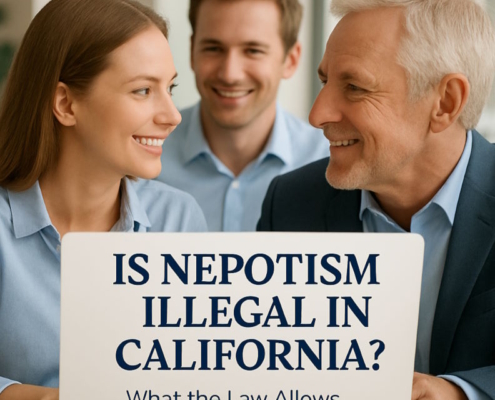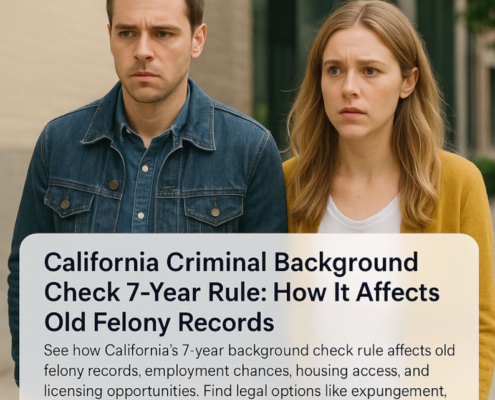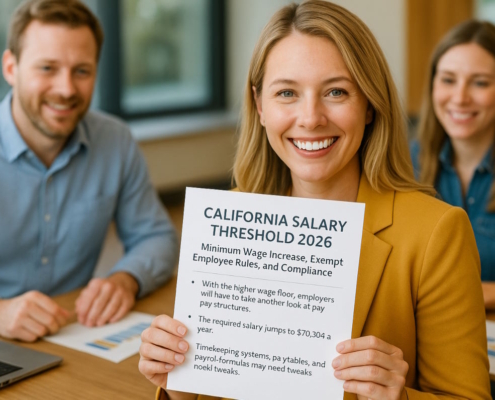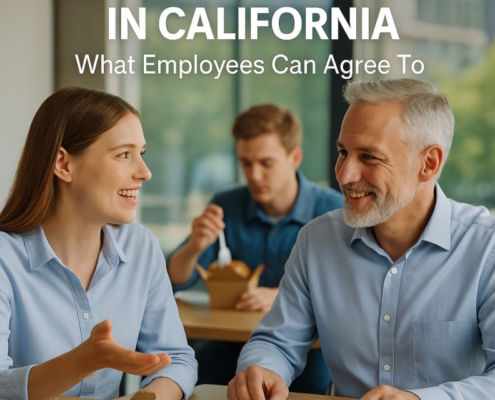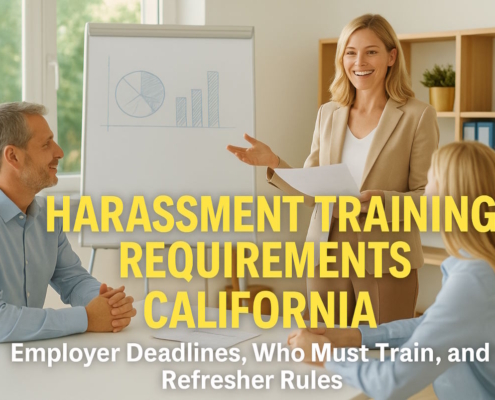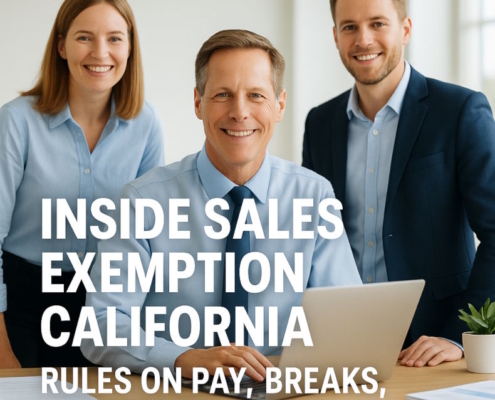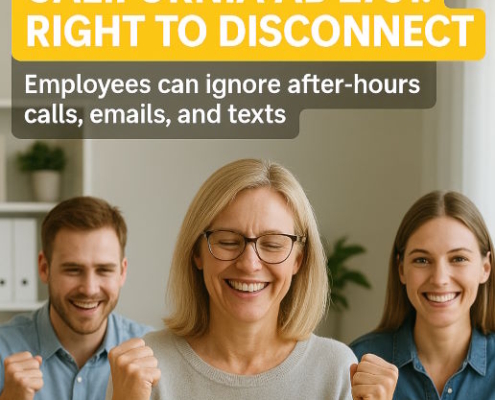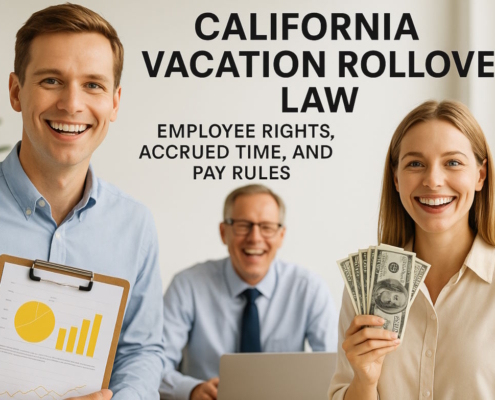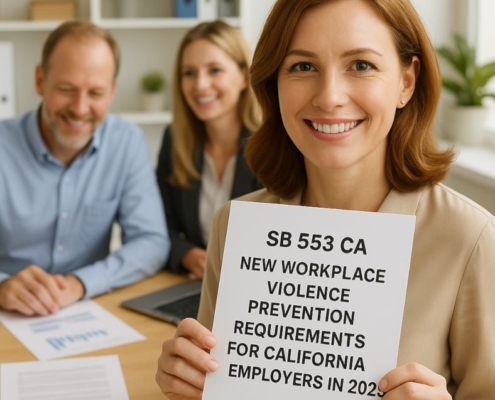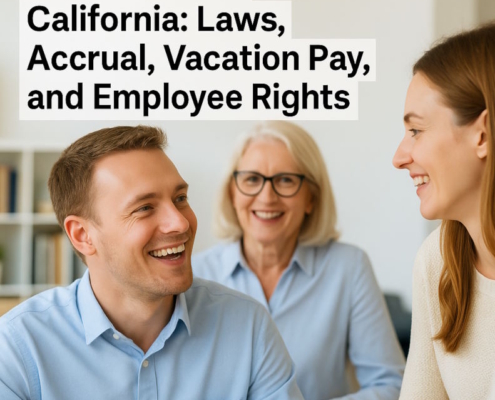Constructive Termination in California
By Douglas Wade, Attorney
Email | Call (800) 484-4610
Definition
Constructive discharge occurs when an employer’s conduct effectively forces an employee to resign. (Simers v. Los Angeles Times Communications, LLC (2018) 18 Cal.App.5th 1248, 1269 citing Turner v. Anheuser-Busch, Inc. (1994) 7 Cal.4th 1238, 1243-44.)
While the employee may quit his employment with the employer, the employment relationship is actually severed involuntarily by the employer’s acts (or failure to act), against the employee’s will. (Turner v. Anheuser-Busch, Inc. (1994) 7 Cal.4th 1238, 1244-45.) As a result, the constructive discharge is legally regarded as a firing rather than a resignation. (Vasquez v. Franklin Management Real Estate Fund, Inc. (2013) 222 Cal.App.4th 819, 827.)
“Standing alone, constructive discharge is neither a tort nor a breach of contract, but a doctrine that transforms what is ostensibly a resignation into a firing.” (Turner v. Anheuser-Busch, Inc. (1994) 7 Cal.4th 1238, 1251.) After establishing constructive discharge, an employee must independently prove a breach of contract or a tort in connection with the employment termination in order to obtain damages for wrongful discharge. (Starzynski v. Capital Public Radio, Inc. (2001) 88 Cal.App.4th 33, 40.)
If you’re an employer and need a employment lawyer to defend against an employee’s lawsuit, please contact our attorney for a free consultation.
Elements of Constructive Discharge / Constructive Termination
In order to establish a constructive discharge, an employee must prove, by a preponderance of the evidence, that
- The employer either intentionally created or knowingly permitted working conditions;
- That were so intolerable or aggravated at the time of the employee’s resignation;
- That a reasonable employer would realize;
- That a reasonable person in the employee’s position would have felt compelled to resign.
(Turner v. Anheuser-Busch, Inc. (1994) 7 Cal.4th 1238, 1251.)
The requisite knowledge or intent must exist on the part of either the employer or those persons who effectively represent the employer, such as its officers, directors, managing agents, or supervisory employees. (Ibid.)
Constructive Discharge: Breach of Contract
An employee may prove that a constructive discharge is a breach of an express or implied, written or oral, contract of employment. In the absence of an express or implied agreement to the contrary, all contracts of employment without a fixed term are presumed to be terminable at the will of either party at any time. (Cal. Lab. Code, § 2922; Foley v. Interactive Data Corp. (1988) 47 Cal.3d 654, 675-682.)
However, in the employment arena, additional factors may be considered in order to evaluate the existence and content of an employment agreement. These factors include the personnel policies or practices of the employer, the employee’s longevity of service, actions or communications by the employer reflecting assurances of continued employment and the practices of the industry in which the employee works. (Id. at 680.)
For example, a constructive discharge may amount to a breach of an employer’s express or implied agreement not to terminate except in accordance with specified procedures or without good cause. (Starzynski v. Capital Public Radio, Inc. (2001) 88 Cal.App.4th 33, 40.)
Constructive Discharge: Tort
An employer cannot terminate an employee for reasons contravening fundamental public policy, as expressed in a constitutional or statutory provision. Gantt v. Sentry Insurance (1992) 1 Cal.4th 1083, 1094-1095.) A constructive discharge in violation of fundamental public policy gives rise to a tort action in favor of the terminated employee. (Foley v. Interactive Data Corp. (1988) 47 Cal.3d 654, 675-682; Tameny v. Atlantic Richfield Co. (1980) 27 Cal.3d 167, 178.)
Element 1: Intolerable or Aggravated Working Conditions
“Although situations may exist where the employee’s decision to resign is unreasonable as a matter of law, ‘[w]hether conditions were so intolerable as to justify a reasonable employee’s decision to resign is normally a question of fact.’ “ (Vasquez v. Franklin Management Real Estate Fund, Inc. (2013) 222 Cal.App.4th 819, 827.)
The conditions giving rise to the resignation must be sufficiently extraordinary and egregious to overcome the “normal motivation of a competent, diligent, and reasonable employee to remain on the job to earn a livelihood and to serve his or her employer.” (Turner v. Anheuser-Busch, Inc. (1994) 7 Cal.4th 1238, 1246.) The focus is on whether the resignation was coerced, not whether it was one rational option for the employee. (Ibid.)
An employee cannot simply “quit and sue,” claiming he was constructively discharged. (Turner v. Anheuser-Busch, Inc. (1994) 7 Cal.4th 1238, 1246.)
In order to amount to a constructive discharge, the adverse working conditions must be unusually aggravated or amount to a continuous pattern before the situation will be deemed intolerable. (Turner v. Anheuser-Busch, Inc. (1994) 7 Cal.4th 1238, 1247.) Single trivial or isolated acts are insufficient to support a constructive discharge claim. (Ibid.) For example, a poor performance rating or a demotion, even when accompanied by a reduction in pay, does not, by itself, trigger a constructive discharge. (Ibid; see also Valdez v. City of Los Angeles (1991) 231 Cal.App.3d 1043, 1056.)
Examples
- Over her six-year period of employment, plaintiff was not selected for the position of assistant controller, was told that the company’s CFO did not see a woman in a controller position, and was excluded from executive meetings. On these facts, the court concluded that there was no evidence of constructive discharge. The court noted there might be evidence of gender discrimination, but the fact that plaintiff wanted to remain with the company provided she could have a position reporting to the CFO, demonstrated that plaintiff must not have found her working conditions so intolerable as to render her resignation coerced. (Cloud v. Casey (1999) 76 Cal.App.4th 895, 903-904.)
- Plaintiff resigned her employment after filing various charges with the Equal Employment Opportunity Commission alleging discrimination in training and promotion against her employer. Plaintiff’s employer submitted evidence that plaintiff’s training was the same as everyone else’s within her department and that plaintiff’s lack of promotion was based upon documented poor performance, lack of qualifications, and the fact that plaintiff had submitted a late application for the promotion. Given that all of the company’s employees were treated similarly, the court declined to find that plaintiff was constructively discharged due to intolerable or aggravating work conditions. (Addy v. Bliss & Glennon (1996) 44 Cal.App.4th 205, 218-219.)
Element 2: Objective (Reasonable Employee) Standard
A constructive discharge is evaluated by an objective standard—whether a reasonable person faced with the allegedly intolerable employer actions or conditions of employment would have no reasonable alternative except to quit. (Rochlis v. Walt Disney Co. (1993) 19 Cal.App.4th 201, 212.)
The proper focus is on the working conditions themselves, not on the plaintiff’s subjective reaction to those conditions. (Simers v. Los Angeles Times Communications, LLC (2018) 18 Cal.App.5th 1248, 1272.)
Examples
- After plaintiff complained of sexual harassment, she received what she considered to be an unfavorable performance evaluation and was not considered for promotion to a management position. The person about whom plaintiff complained was reprimanded, and plaintiff was thanked for calling the issue to the company’s attention. The company reviewed plaintiff’s performance appraisal at plaintiff’s request, and issued an addendum to it responding to plaintiff’s comments and suggestions, though the company did not modify plaintiff’s rating or salary increase. The court concluded that, in light of the employer’s interest and sympathy towards plaintiff’s complaints, no reasonable person in plaintiff’s position would have believed she was being forced out of the company and compelled to resign. (Casenas v. Fujisawa USA, Inc. (1997) 58 Cal.App.4th 101, 115-116.)
- Three years after plaintiff complained to his employer of illegal activities that violated company policy, he received a “needs improvement” performance review, and plaintiff resigned. The court found that plaintiff’s resignation was not a constructive discharge because plaintiff failed to demonstrate that he was subjected to working conditions rendering his job so intolerable that a reasonable person would have felt compelled to resign. (Turner v. Anheuser-Busch, Inc. (1994) 7 Cal.4th 1238, 1245-49.)
Element 3: Employer Knowledge or Intent
The employer or the employer’s representative must have created or known of the intolerable conditions causing the forced resignation of the employee. (Turner v. Anheuser-Busch, Inc. (1994) 7 Cal.4th 1238, 1249.) An employer’s actual knowledge of the existence of such conditions, and subsequent failure to remedy them, may constitute circumstantial evidence that the employer deliberately forced the employee to resign. (Ibid.) It is not necessary, however, that a plaintiff prove that the employer’s actions were taken with an express intent to cause the employee to quit. (Ibid.)
Examples
- As a consequence of plaintiff reporting her fellow employees’ misappropriation of state funds and equipment, the Vice President of Administration and Finance of the University ordered plaintiff’s supervisors to document plaintiff for future termination; changed plaintiff’s position five times (after her 21 years of service with the department), stripping her of her responsibilities; and gave plaintiff extensive work assignments, even though her doctor had specifically ordered that she not work more than 4 hours per day due to her diagnoses of stress and fibromyalgia. The court concluded that a trier of fact could reasonably infer that plaintiff’s employer had knowledge of this continuous pattern of adverse working conditions resulting in plaintiff’s constructive discharge. (Colores v. Board of Trustees (2003) 105 Cal.App.4th 1293, 1302.)
- Plaintiff claimed that while on medical leave, he received notice that his employer was going to demote him and reduce his pay and sick leave when he returned. Plaintiff resigned instead of returning to work; he claimed constructive termination. The Supreme Court held that plaintiff had to prove that his employer either intentionally created or knowingly permitted the intolerable working conditions to establish that the resignation was employer-coerced. An aggrieved employee must provide his employer with notice of the allegedly intolerable conditions before quitting and initiating a lawsuit. (Mullins v. Rockwell International Corp. (1997) 15 Cal.4th 731, 738-739.)
- After 22 years of service with his employer, plaintiff was told he was not the right person to head the west coast field sales force. The employer submitted evidence that plaintiff had fallen asleep at business meetings; that an important customer in plaintiff’s region repeatedly complained about plaintiff’s performance; that plaintiff showed no interest in increasing profits and had very little knowledge about the distributors in his region; and that recent sales in plaintiff’s region were flat. Plaintiff accepted a demotion – a field sales position within the company, but made very few sales calls and, ultimately, left the company. Plaintiff claimed he was constructively discharged. The court found that plaintiff’s demotion and reduction in pay were not enough to compel a reasonable person to resign due to allegedly aggravated or intolerable working conditions. Plaintiff was not permitted to quit and sue simply because he did not like his new job assignment or was embarrassed by it. Because plaintiff never complained that he found his new job assignment and working conditions intolerable, he could not establish that his employer had knowledge of these allegedly intolerable conditions and, therefore, deliberately created them or knew of them and failed to remedy the situation in order to force plaintiff to resign. (Gibson v. Aro Corp. (1995) 32 Cal.App.4th 1628, 1631-1640.)
Remedies
Constructive Discharge: Breach of Contract / Contract Damages
Contract damages are of two types – general damages (sometimes called direct damages) and special damages (sometimes called consequential damages). (Lewis Jorge Construction Management, Inc. v. Pomona Unified School Dist. (2004) 34 Cal.4th 960, 968.)
“ ‘Contract damages are generally limited to those within the contemplation of the parties when the contract was entered into or at least reasonably foreseeable by them at that time; consequential damages beyond the expectation of the parties are not recoverable. This limitation on available damages serves to encourage contractual relations and commercial activity by enabling parties to estimate in advance the financial risks of their enterprise.’ ‘In contrast, tort damages are awarded to [fully] compensate the victim for [all] injury suffered.’ ” (Erlich v. Menezes (1999) 21 Cal.4th 543, 550.)
Equitable Remedies Not Available
The obligation to employ another in personal service cannot be specifically enforced. (Cal. Civ. Code, §3390.)
Punitive Damages Not Available
California courts do not recognize a right to punitive or exemplary damages for breach of contract, unless the breach occurs in connection with an intentional tort. (Foley v. Interactive Data Corp. (1988) 47 Cal. 3d 654, 700.
Emotional Distress Damages Typically Not Available
Cases permitting recovery for emotional distress typically involve mental anguish stemming from more personal undertakings the traumatic results of which were unavoidable. Thus, when the express object of the contract is the mental and emotional well-being of one of the contracting parties, the breach of the contract may give rise to damages for mental suffering or emotional distress. (Erlich v. Menezes (1999) 21 Cal.4th 543, 559.)
Attorney’s Fees if Provided For in Employment Contract
“In the absence of a statute authorizing attorneys’ fees as an element of damages, or of a contract to pay such fees in event of the party’s recovery, attorneys’ fees paid by a successful party in an action are never recoverable against the unsuccessful party.” (Jen–Mar Constr. Co. v. Brown (1967) 247 Cal.App.2d 564, 573; Cal. Code Civ. Proc., § 1021.)
Constructive Discharge: Tort
Compensatory Damages
Compensatory damages including lost income and general damages for emotional distress are available. (See Gantt v. Sentry Ins. (1992) 1 Cal. 4th 1083.)
Lost Compensation
Back Pay
Back pay restores a plaintiff in a wrongful termination (constructive discharge) case to the position he or she would have occupied but for the constructive discharge. (Lozada v. City and County of San Francisco (2006) 145 Cal.App.4th 1139.)
Front Pay
Front pay as the term is used in employment litigation, is a measure of damages for loss of future income, as opposed to backpay, which is lost-wages damages through the time of trial. If the judge orders reinstatement of a fired employee, front pay might be awarded to make up a wage differential if there were no vacancy into which the employee could immediately be reinstated or promoted. (Horsford v. Board of Trustees of California State University (2005) 132 Cal.App.4th 359.)
Punitive Damages
Where an action is pleaded for constructive discharge in violation of public policy, the same opportunity to plead and recover punitive damages exists. (See Gantt v. Sentry Ins. (1992) 1 Cal. 4th 1083.)
Attorneys’ Fees and Costs
The court, in its discretion, may award to the prevailing party, including the department, reasonable attorney’s fees and costs, including expert witness fees. (Gov. Code, § 12965, subd. (b).)
Statute of Limitations
Breach of Contract
The statute of limitations on breach of an oral agreement is two years from the date of the breach; on a written agreement, the statute runs four years from the date of breach. (Cal. Code Civ. Proc., §§ 337 [written contract], 339 [oral contract].) A claim for wrongful discharge in violation of a contract, oral or written, follows these same time frames.
In a contract action based upon a constructive discharge, the statute does not commence when the employee’s working conditions become intolerable, but when the employee resigns. (Mullins v. Rockwell International Corp. (1997) 15 Cal.4th 731, 743.)
Tort
The statute of limitations for a tort-based claim for constructive discharge is one year from the date of termination. (Cal. Code Civ. Proc., § 340; Barton v. New United Motor Manufacturing (1996) 43 Cal.App.4th 1200, 1208-1209.) The statute of limitations begins to run at the time of discharge, not when the plaintiff is notified of the potential discharge. (Mullins v. Rockwell International Corp. (1997) 15 Cal.4th 731, 743.)
Affirmative Defenses
After-Acquired Evidence Doctrine
The defense of after-acquired evidence doctrine shields employer from liability or limits available relief where, after termination, employer learns for the first time about employee wrongdoing that would have led to discharge in any event. (Camp v. Jeffer, Mangels, Butler & Marmaro (1995) 35 Cal.App.4th 620, 632-35.)
Employee’s Duty to Mitigate Damage
“The general rule is that the measure of recovery by a wrongfully discharged employee is the amount of salary agreed upon for the period of service, less the amount which the employer affirmatively proves the employee has earned or with reasonable effort might have earned from other employment. However, before projected earnings from other employment opportunities not sought or accepted by the discharged employee can be applied in mitigation, the employer must show that the other employment was comparable, or substantially similar, to that of which the employee has been deprived; the employee’s rejection of or failure to seek other available employment of a different or inferior kind may not be resorted to in order to mitigate damages.” (Parker v. Twentieth Century-Fox Film Corp. (1970) 3 Cal.3d 176, 181-182; see also Rabago-Alvarez v. Dart Industries, Inc. (1976) 55 Cal.App.3d 91, 98 [“Plaintiff concedes that the trial court was entitled to deduct her actual earnings”]; but see Villacorta v. Cemex Cement, Inc. (2013) 221 Cal.App.4th 1425, 1432 [wages actually earned from an inferior job may not be used to mitigate damages].)
ERISA Preemption
In a tort-based action, if an employee alleges motivating factor underlying termination was employer’s desire to prevent employee’s continued receipt of benefits. (29 U.S.C. §§ 1001-1461; see Ingersoll-Rand Co. v. McClendon (1990) 498 U.S. 133, 140.
Have a quick question? We answered nearly 2000 FAQs.
See all blogs: Business | Corporate | Employment
Most recent blogs:




